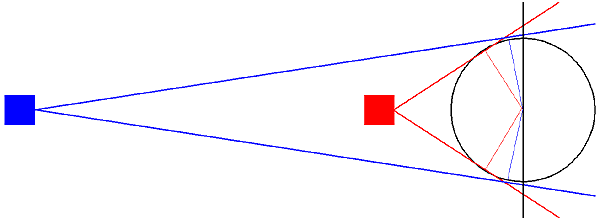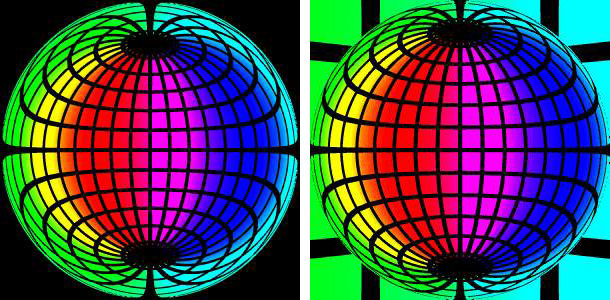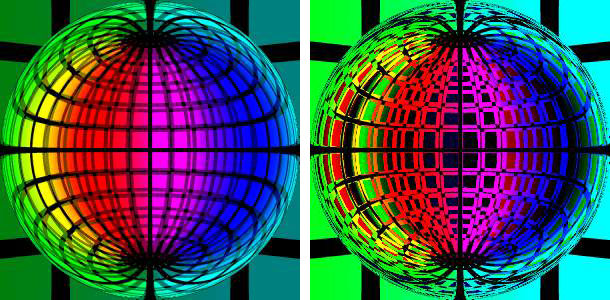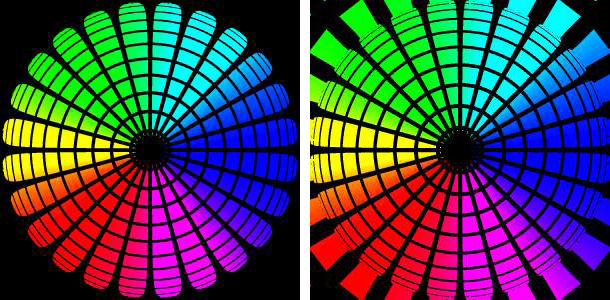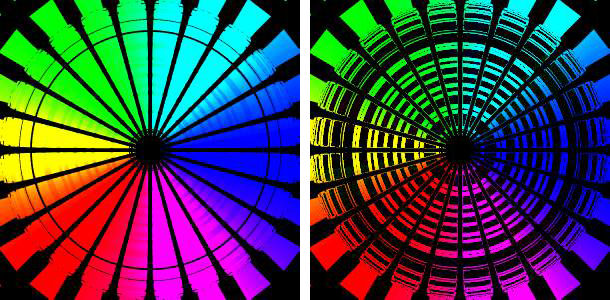
< 3D World
> Intro
> Overview
• Distortions
— 3D World: Mirror Ball, Distortions —
Field of View onto the Surface of the Sphere
The more the observer retreats from the sphere, the more of it can be seen and the part actually seen of the surface gets narrower as the sphere is approached.
The blue camera sees more of the sphere than the red one. What the camera cannot see is missing in the photograph. To better observe what happens, a mirror ball was placed into a spherical cage. The ribs are vertically and horizontally separated by 15° from each other — longitude and latitude.
Equatorial View
Equatorial means the camera is opposite the mirror ball in the horizontal plane. The camera can also look down on the sphere from above — the Polar View will be discussed as well.
The part of a mirror ball facing the observer shows the whole environment, except the part that is obscured by the sphere itself. The environment at the sides of the sphere are reflected sideways from the centre up to the visible edge. The reflections get increasingly compressed.
The camera is farther away from the sphere in the left image than in the right one. The sphere has a diameter of 2 units, the camera in the left picture was 80, the one at right 2.5 units away from the sphere; the FoV (field of view) for the Bryce cameras are 1° (100%) left and 59° (100%, actually 44°) right.
In the left picture, the longitdes can be followed up to 175° and the latitudes at the poles down to 15°. On the right picture, the longitudes get lost after 120° already and at the poles, the latitudes can be seen only down to 45°.
The left picture has the 1° and 59° images combined, the right one has the 59° substracted from the 1° one. The differences are quite obvious. You will not be able to photograph with a 1° FoV lens, and a photograph of a mirror ball at 59° FoV will be hard to get focused. Here, extremes are shown, your own photographs will be somewhere in between. Anyway, it becomes evident why you sould prefer a tele lens over a wide angle lens.
Polar View
Polar means the camera is opposite the mirror ball in the vertical plane. The camera looks
down on the north pole or looks up to the south pole. The distortions are different from
those for the Equatorial View. Everything that is around the sphere in the horizontal plane
is equally reflected and equally compressed. This is a good choice for dome panoramas.
However, in the field, it will be difficult to find a suitable place for the camera above
the mirror ball from which the camera can still be operated. If you are about to create a
full sphere panorama, you have to think about how you could fix the sphere above the
camera.
The part of a mirror ball facing the observer shows the whole environment, except the part that is obscured by the sphere itself. The part below (or above) the sphere is reflected down (or up) to and beyond the equator approaching the opposite pole. The reflections get increasingly compressed towards the edge of the sphere.
The camera is farther away from the sphere in the left image than in the right one. The sphere has a diameter of 2 units, the camera in the right picture was 80, the one at right 2.5 units away from the sphere; the FoV (field of view) for the Bryce cameras are 1° left and 59° right.
In the left picture, the latitudes can be followed down to 75° south. At the right side, the latitudes get lost after 45° south already. There is no problem for the longitudes.
The left picture has the 1° and 59° images combined, the right one has the 59° substracted from the 1° one. The differences are obvious.
© 2004 - 2018 by Horo Wernli.
